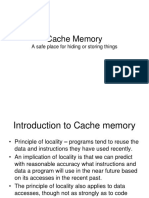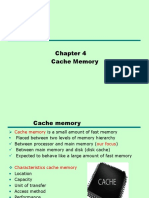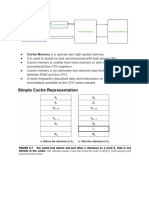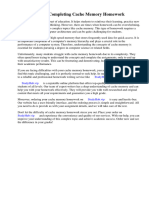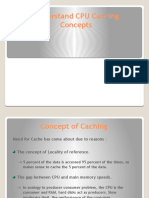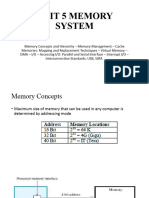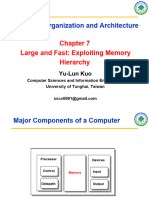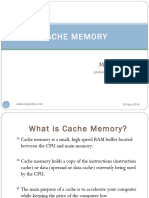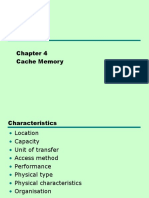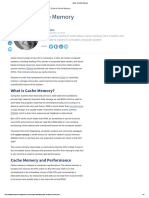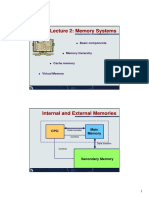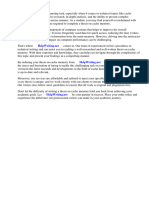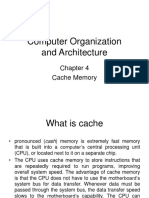0 ratings0% found this document useful (0 votes) 38 views13 pagesCache Memory
Copyright
© © All Rights Reserved
We take content rights seriously. If you suspect this is your content,
claim it here.
Available Formats
Download as PDF or read online on Scribd
Cache Memory
Special very high-speed memory that acts as a buffer between RAM and the
CPU.
Used to speed up and synchronizing with high-speed CPU,
An extremely fast memory type Holds frequently requested data and
instructions so that they are immediately available to the CPU when needed.
Technique of storing a copy of data temporarily in rapidly accessible storage
media (also known as memory) local to the CPU and separate from bulk
storage.
a
Cache Memory�Cache Memory
Costlier than main memory or disk memory but economical than
CPU registers.
Used to reduce the average time to access data from the Main
memory.
Smaller and faster memory ( 5 to 10 times) which stores copies of
the data from frequently used main memory locations.
Instructions of few localized area of the program are repeatedly
executed. while remainder of program is accessed relatively less.
This phenomenon is referred as Locality of Reference�Levels of Cache Memory
Level 1(L1) Cache:
e@ Fastest cache and usually comes
within the processor chip itself
e The LI cache typically ranges in size
from 8KB to 64KB and uses the high-
speed SRAM (static RAM) instead of
DRAM (dynamic RAM).
e Referred as internal cache or primary�Levels of Cache Memory
Level 2(L2) Cache: Level 3(L3) Cache:
e This cache is larger but slower in @ An enhanced form of memory
speed than L1 cache: present on the motherboard of the
@ Stores recently accessed information computer.
& also known as secondary cache, e Used to feed the L2 cache.
e [2 cache comes between Ll and e Faster than the system’s main
RAM and is bigger than the primary memory, but slower than L2
cache (typically 64KB to 4MB). cache.
e Having more than 3 MB of storage
nit�Placement of Cache Memory in processor�Mapping Function
Processor issues a Read request. a block of words is transferred
from the main memory to the cache. one word at a time.
Subsequent references to the data in this block of words are found
in the cache.
At any given time, only some blocks in the main memory are held
in the cache. Which blocks in the main memory are in the cache is
determined by a “mapping function”.�Mapping Function
When the cache is full. and a block of words needs to be
transferred from the main memory. some block of words in the
cache must be replaced. This is determined by a “replacement
algorithm”.
Block Transfer
Word Transfer
mo
ae�iG i ©
5
Cache Operation
.
CPU requests content of memory
location.
Checks Cache for this data
If present get it from there(Fast)
If not present. read required block
from main memory to cache.
Then deliver from cache to CPU.
Cache includes tags to identify which
block of main memory is in each
cache slot.�Hit Ratio
Cache Hit Ratio is the ratio of the number of cache hits to the number
of lookups, usually expressed as a percentage.
Depending on the nature of the cache. expected hit ratios can vary from
60% to greater than 99%,
+ Cache Hit = Desired data is in current level of cache
* Cache Miss = Desired data is not present in current level.
* When a cache miss occurs. the new block is brought from the lower level into cache.
If cache is full a block must be evicted
Number of cache hits
we (Number of cache hits + Number of cache misses)
—
=Cache hit ratio�Hit Ratio-Problem
Calculate the average access time of memory for a computer with cache access
time of 100ns, a main memory access of 1000ns and a hit ratio is 0.9�Hit Ratio-Problem
Calculate the average access time of memory for a computer with. L_cache access
time of 100ns. a main memory access of 1000ns and a hit ratio is 0.9
— ———————— ———
Fo + /. F data is Purd Gche
= (o-ax lens ee (1-0-9) x loons + looses
= Joys + loys�Writing into the Cache
When memory write operations are performed, CPU
first writes into the cache memory. These modifications
made by CPU during a write operations, on the data
saved in cache, need to be written back to main
memory or to auxiliary memory.
These two popular cache write policies (schemes) are:
¢ Write-Through
¢ Write-Back�Writing into the Cache
Two popular cache write policies (schemes) are:
Write-through
The main memory is updated each
time the CPU writes into cache.
Pros: Avoid coherency issues
between levels.
Cons: Poor performance if
next level of hierarchy is slow
or if many, repeated accesses
Write-back
Only the cache memory is updated
during a write operation.
and the updated locations in the
cache memory are marked by a flag.
The words are removed from the
cache time to time to make room for
a new block of words.
* Pros : Fast if many repeated
accesses
* Cons : Coherency issues






